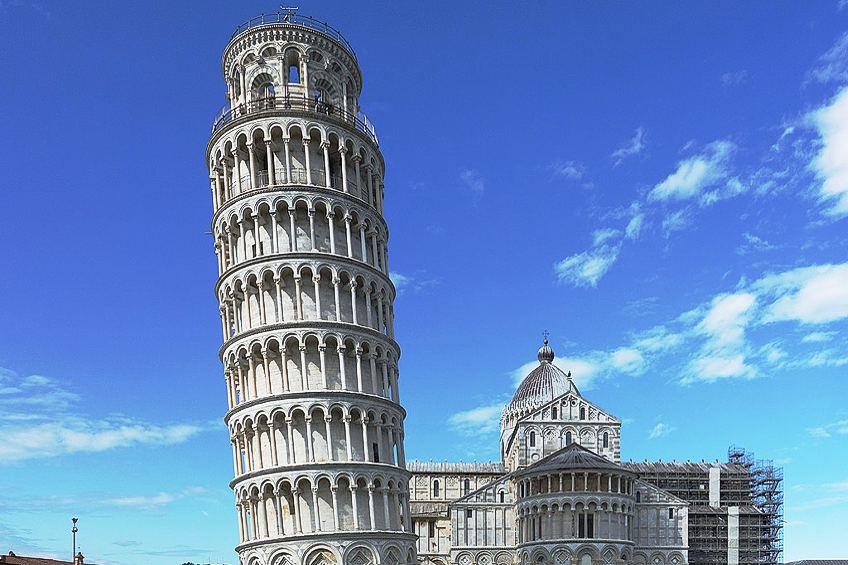Leaning Tower of Pisa – A World-Famous Mystery
The Leaning Tower of Pisa is a famous building in Italy that is particularly known for the pronounced lean from which the bell tower has received its name. The bell tower of the Pisa Cathedral is also notable for its Romanesque architectural style. In this article, we will answer several questions about the Leaning Tower of Pisa, such as: “Where is the Tower of Pisa located, how tall is the Leaning Tower of Pisa, and what is the angle of the Tower of Pisa?”. These questions, alongside a few others, will be our focus in the discussion below. So, let’s talk about the Leaning Tower of Pisa!
A Look at the Leaning Tower of Pisa
| Architect | Possibly Diotisalvi (12th century) |
| Date Constructed | 1173 – 1372 |
| Function | Bell tower |
| Materials Used | Marble and limestone |
| Height (High Side and Low Side) | 56.67 meters (or 185.11 ft) and 55.86 meters (or 183.3 ft) |
| Location | Pisa, Italy |
The bell tower, known as the Leaning Tower of Pisa, which also goes by the less-illustrative name the “Tower of Pisa”, can be found sitting beside the Pisa Cathedral. So, where is the Tower of Pisa located then? Well, the city of Pisa, which is likely most notable because of the bell tower within its territory. The reason this particular tower has become known as a leaning tower will be explored in greater detail below, but as it is probably one of the most famous buildings in the world and a veritable symbol of the Italian state, it is likely that its iconic image is already known.

The Leaning Tower of Pisa is so named because of the pronounced four-degree lean that the structure attained during its construction. This means that the tower was leaning long before it was actually finished, and yet they continued to build it. The lean has also worsened over the centuries, but the lean has not rendered the site unsafe. It can be visited, and one can even climb to the very top of the tower if one so chooses. A common experience for many who visit the Leaning Tower of Pisa is that the structure is actually quite small beside the Pisa Cathedral of which it is technically a part. It is the bell tower of that cathedral, but the bells do not ring all that often anymore.
It has instead, in more recent decades, become a tourist spot. So, let us have a look at the history of this famous building in Italy.
The History of the Leaning Tower of Pisa
The Leaning Tower of Pisa took nearly 200 years to complete. The structure started its planning when the area was bequeathed to the church, and the construction officially started in 1173. The construction of this building took a number of years, but in 1178, the tower started to sink. This was at about the time that the construction had managed to reach the second of the proposed floors. The reason for this sinking will be explored in more detail below, but in basic terms, the soil was unstable.
Construction did halt for a time, but ultimately continued after the soil had settled again.
The tilt became part of the construction as the builders attempted to compensate for the lean by building one side to be taller than the other side. The idea was to try and create an equilibrium between them, but this did not actually work seeing as the building is famously known as the Leaning Tower of Pisa today. Construction came to a halt once again in 1284, but this was because of a war between the Pisans and the Genoese. The construction would eventually resume, and the final story was ultimately completed in 1319. The bells were added several decades later though. The tilt that the Leaning Tower of Pisa possessed would slowly grow and become more pronounced over the centuries.

However, after the structure was officially completed, there were a few notable events that occurred. It is said that Galileo Galilei used the tower to test whether objects of different masses fall at the same speed, but this is a claim that was made after his death. It has become a popular part of the mythology around the Leaning Tower of Pisa though. In terms of more definitive events, the tower also served a role in the Second World War. There was a belief that the tower was being used by the Germans as an observation post, and so it was almost destroyed in an American artillery strike. Luckily, those in charge decided against bombing it.
The other biggest thing to happen to the Leaning Tower of Pisa has been the restoration efforts.
A literal lean to a building is not a particularly good situation to be in, and as such, the tower was in actual danger of falling over for good. There were attempts in the 1960s to reduce the tilt, but they ultimately came to nothing. It took until the 1990s for decisions to be definitively made to take proper precautions and make repairs. This will be further discussed below, but the tilt was ultimately alleviated by a few degrees to make the tower less likely to collapse.
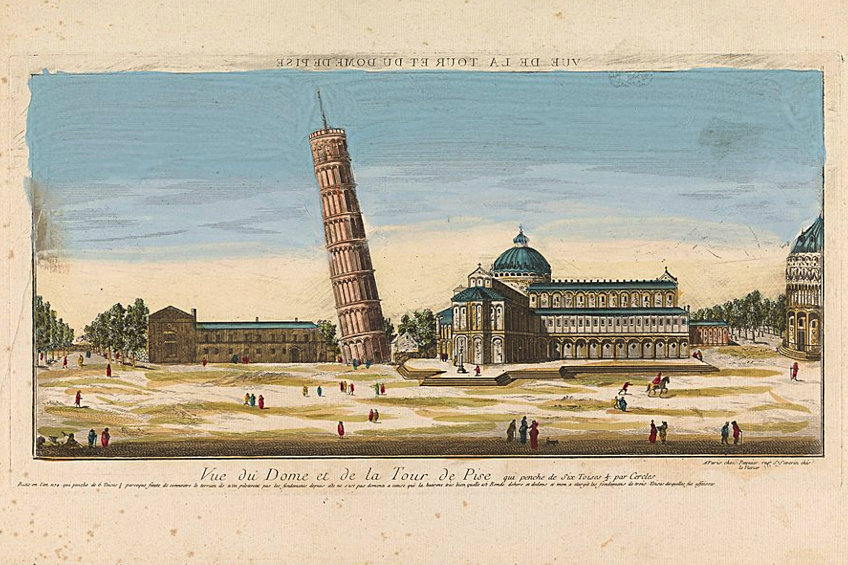
Other than this, the Leaning Tower of Pisa has effectively ceased in its old duties as a bell tower as the bells are not sounded all that often. However, this incredibly famous building in Italy has become a major tourist destination while remaining one of the most famous in the world.
It’s understandable that they would want to preserve the building as best as possible.
The Architecture of the Leaning Tower of Pisa
The majority of the Leaning Tower of Pisa is marble, and the white façade of the building has become one of its most notable features (other than the eponymous lean, of course, but that will be discussed in further detail below). However, the structure did also make use of limestone and mortar to ensure that it would be able to remain standing. The general architectural style of the Pisa Tower inside and outside is Romanesque. This particular style was one that would develop over several centuries and can be seen as starting as early as the 6th century, but by the 12th century, it had been effectively replaced as the most common style by Gothic architecture.
Romanesque architecture is noted for its use of thick walls, barrel vaults, large towers, and arcades that make use of decorative elements.
The style, especially when juxtaposed against the Gothic style that would replace it, was a rather simple style. It was elegant and generally quite basic. The structures that typically made use of this architectural style were, most commonly, castles and churches. Some of the earliest castles in Europe made use of Romanesque architecture. In terms of the Leaning Tower of Pisa, and the cathedral beside it, the Romanesque style was the most common choice at the time. For this reason, this famous bell tower has become one of the most notable instances of existing Romanesque architecture and a particularly strong representation of Pisan Romanesque architecture.
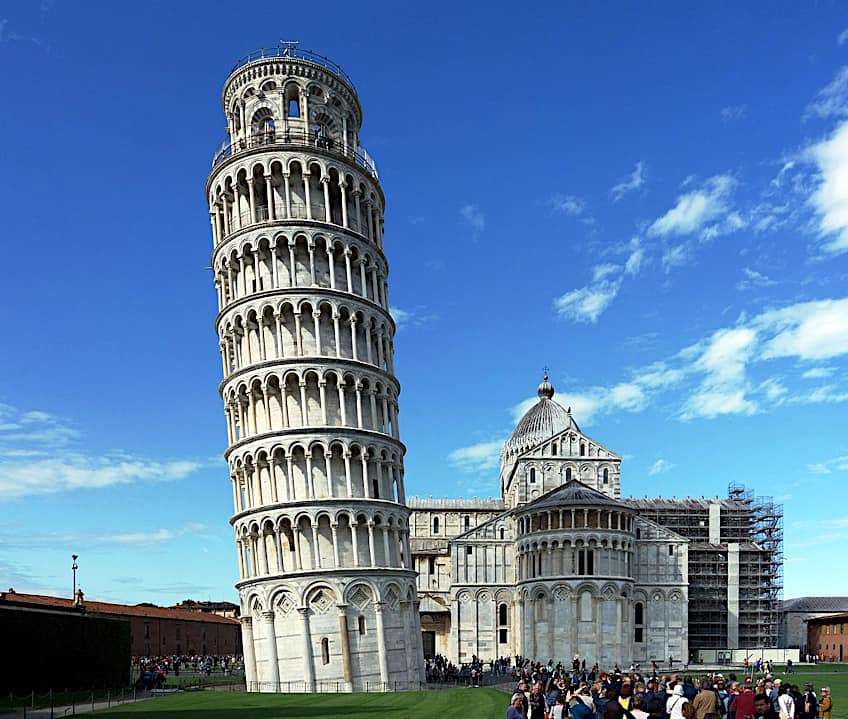
The tower makes use of 207 marble columns along its length, and each of these columns makes use of different styles and capitals. They are decorated with various images, such as vegetal forms and animals. The design of the tower itself is also circular, which was common in Romanesque designs, and it makes use of thick walls with a diameter of 15.5 m. This is the exterior of the Pisa Tower. Inside the famous structure, there are two spiral staircases with nearly 300 steps. The tilt of the tower is also seen inside the structure as the staircase on the shorter side has fewer steps.
Ultimately, the Leaning Tower of Pisa has remained a stunning piece of Romanesque architecture and the fame that it has attained has only improved with the engineering mistake that is its lean.
The Architect of the Leaning Tower of Pisa
The Leaning Tower of Pisa may be an iconic and famous building in Italy, but because of its age, there are certain things that are, simply, not known about it. One of those things is the definite architect of the tower. It was believed, for a long time, that the main architects were Guglielmo and Bonanno Pisano, who were residents of the city and artists from that period. However, this has been disputed.
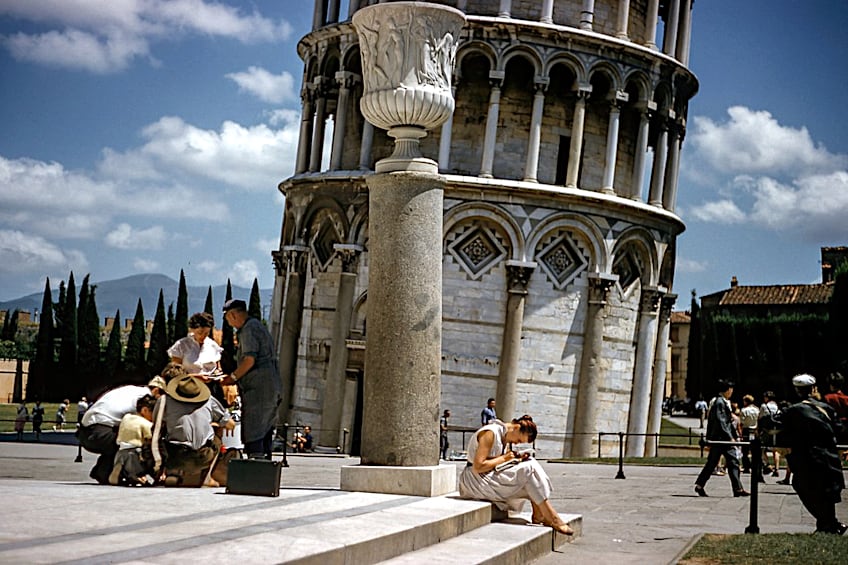
Another figure who has been suggested was Diotisalvi. This man was an architect from Pisa, but we have so little information about this particular architect. The reason there is some belief that he may have had a hand in the structure is because he was in Pisa at the time, and it appears to share certain similarities to other structures that he designed in Pisa. However, we cannot be certain about this information.
The Cathedral Beside the Leaning Tower of Pisa
The Leaning Tower of Pisa may be the most famous thing in Pisa, but it is actually only part of a far larger Christian complex in the region. The tower itself is, particularly, the bell tower of the Pisa Cathedral. So, what is notable about this cathedral then? Well, it is a Roman Catholic cathedral that is dedicated to the Virgin Mary, and much like the tower, it has become a UNESCO Heritage Site. Furthermore, it also makes use of a Romanesque architectural style.
The Pisa Cathedral is actually older than the Leaning Tower of Pisa, but this does make sense as a cathedral would generally come before its bell tower.
The design goes back to 1063, and the design was meant to be a reflection of the prosperity and power of Pisa itself. The city was a major center in Italy at the time, and so this desire to project this authority does make sense. The cathedral would later be enlarged during the 12th and 14th centuries. The architecture of the Pisa Cathedral is similar to that of the Leaning Tower of Pisa, and it also makes use of a white marble façade. There are also mosaics, sculptures, Islamic-style arches, and large bronze doors. The interior of the cathedral is similarly Romanesque, and it includes columns, a marble pulpit, various sculptures, and even a canopy decorated with a variety of bronze angels.
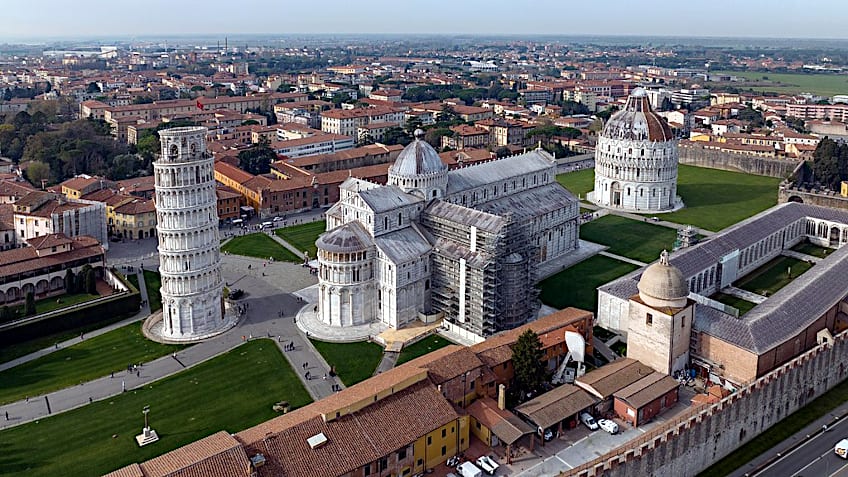
In addition to this, the Pisa Cathedral is home to a major supposed relic of the faith. There is a supposed piece of the True Cross from the Passion of the Christ narrative in the Christian Bible (in other words, the cross on which Jesus Christ was crucified). However, this relic has not been verified as genuine and could have been a forgery, as these were once quite common.
The Cause of the Lean in the Leaning Tower of Pisa
The most famous thing about the Leaning Tower of Pisa is, of course, the lean. So, what was the cause of that lean, and what is the angle of the Tower of Pisa? The lean of the Leaning Tower is an interesting thing, and it’s because of the unstable soil on which the structure was constructed. That soil is made up of a combination of elements, like clay, shells, and sand, and one side of the tower has more compressible soil than the other side. This then caused the tower to lean.
Another interesting thing is that the lean started during the building of the tower, and it caused issues for the construction of the tower itself.
When the tower was completed in the 13th century, it had a lean of 1.4 degrees. This is not too much of a lean, but the thing about unstable soil is that it doesn’t suddenly stabilize just because there’s now a building on top of it. The lean continued to grow more pronounced over the centuries. This all ultimately came to a head in 1990 when the Leaning Tower of Pisa had a 5.5-degree lean. It was at this time when decisions were made to start restoration work in an attempt to rectify the issue. This led to the lean being reduced to 3.97 degrees (although this is often rounded up to 4 degrees for the sake of simplicity).
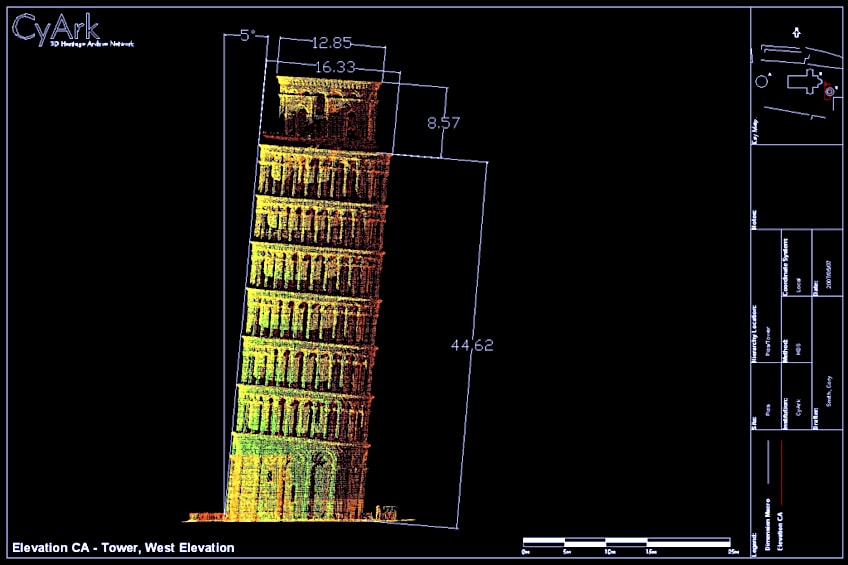
The restoration work did a good job of stabilizing the building to a degree, and while it still has a lean (and the lean is the Leaning Tower of Pisa’s main gimmick), but it is far sturdier than before. However, there have been attempts by other structures to usurp this famous leaning tower’s fame, but many of the structures that have attempted to be more of a leaning tower than the Leaning Tower of Pisa were specifically designed with a lean, and that is a bit unfair.
For instance, the Leaning Tower of Wanaka in New Zealand has a ridiculous lean of 53 degrees, but it’s more of a tourist attraction than a genuine building.
An interesting side effect of the lean of the Leaning Tower of Pisa is that the building now has two heights. There is the height of the higher side, which is 56.67 m (or 185.11 ft), and the height of the shorter side, which is 55.86 m (or 183.3 ft). This means that there is a roughly one-meter difference in the height of the two different sides of the Leaning Tower of Pisa’s roof.
Activities at the Leaning Tower of Pisa
The Leaning Tower of Pisa may have once served as an actual bell tower, but in recent years, it has become more of an attraction that can gain money for the church and region in general. The tower has become a symbol, but a symbol is more useful when it can be converted into something that people definitely want to see, and as such, there are a few attractions in the Pisa Tower’s inside and outside that are worth exploring.
The most obvious of all the attractions for which the Leaning Tower of Pisa is known is the ability to enter the building itself and climb to the very top of the structure.
The climb is gated behind a fee and so tickets need to be purchased to be allowed to do this. However, once at the top of the tower, there is an absolutely gorgeous view of the surroundings as it offers panoramic views of the region. Other than this, one can visit the nearby cathedral, the baptistery, and the massive cemetery that is near the region. The baptistry is actually the largest of its kind and has a similar white marble exterior to the Leaning Tower of Pisa. The cemetery, on the other hand, is covered in a variety of tombs, sculptures, and relics. It is also the cemetery in which many famous Pisans are buried, and these include figures like Galileo Galilei and Fibonacci.
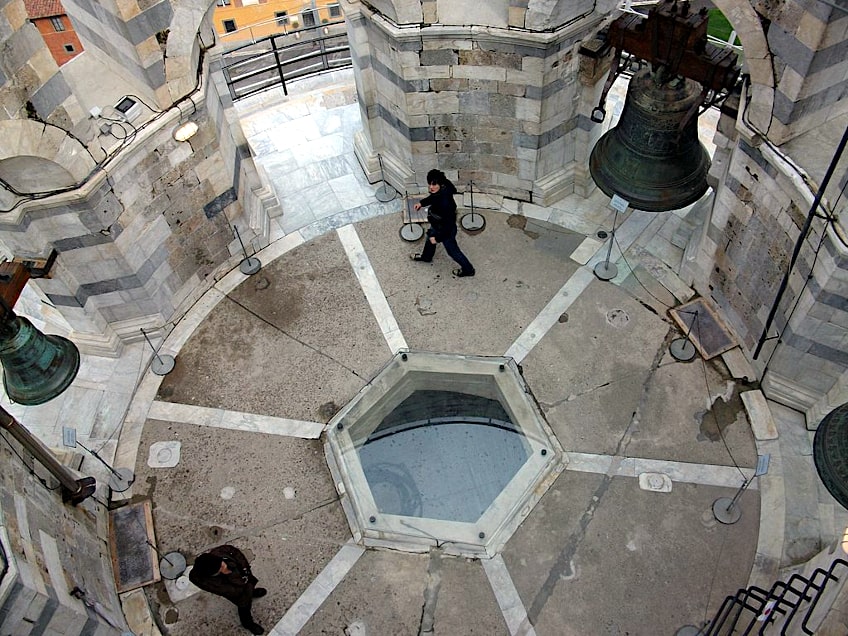
Furthermore, there is a nearby museum that is full of artwork and sketches. However, the most famous thing that many tend to do at the Leaning Tower of Pisa and a definite must-do for everyone who wants to do the touristy things in the city is to pose with the tower. There is a nearby lawn that is often covered in tourists trying to get a photo where they pose as if they are holding up or pushing the Tower of Pisa.
This concludes our look at the Leaning Tower of Pisa. This famous building in Italy is often considered to be a must-visit location for those who have made the trip to the country. In this article, we looked at the history, architecture, and the cause of the lean of this famous leaning tower, as well as a brief aside about the Pisa Cathedral beside it and a few activities that one could do around the tower if one decides to visit. Hopefully, you have learned a good deal about the Leaning Tower of Pisa today, and if you ever get the chance, give it a visit!
Take a look at our Tower of Pisa webstory here!
Frequently Asked Questions
What Is the Leaning Tower of Pisa?
The Leaning Tower of Pisa is an immensely famous building in Italy that has become the most famous structure in the city in which it is located. It is technically a bell tower for the nearby Pisa Cathedral, but the tower itself has become far more famous than the cathedral to which it is attached. The tower is notable for having a considerable lean to the structure itself. The structure is not used as a bell tower all that much any longer, but it has become an immensely popular tourist destination.
How Tall Is the Leaning Tower of Pisa?
The height of the Leaning Tower of Pisa is an interesting thing because, seeing as it leans, it has two heights. The higher side is 56.67 m (or 185.11 ft), while the shorter side is 55.86 m (or 183.3 ft). This means that there is a difference of slightly more than a meter between the two sides of the famous leaning tower. Furthermore, one can climb to the top of the Leaning Tower of Pisa and see a stunning panorama of the region.
What Is the Angle of the Tower of Pisa?
This is another question for which the answer is quite interesting. There is no set angle of the Leaning Tower of Pisa. Instead, the building slowly shifts because of the ground, and this means that, over time, the angle will continue to increase. The angle was at its worst in 1990 when it was 5.5 degrees, but after renovation efforts, it is now 3.97 degrees. When the tower was first constructed, the lean was only 1.4 degrees. However, engineers have deemed the structure safe, and renovation efforts have improved the overall stability of the building for the future.
Where Is the Tower of Pisa Located?
The Leaning Tower of Pisa is, as the name would suggest, a structure that can be found in the city of Pisa. This city is situated within Italy, and the city itself is the capital city of the Province of Pisa. Furthermore, the Leaning Tower of Pisa is only a few minutes away from the Arno River. The whole region has become a major tourist destination within Pisa.
What Is the Architectural Style of the Leaning Tower of Pisa?
The Leaning Tower of Pisa makes use of a Romanesque style. This is a form of medieval architecture that was particularly prominent in castles and cathedrals. This style typically makes use of rounded arches and thick walls. Some of the oldest European castles make use of the Romanesque style, and the Leaning Tower of Pisa is one of the most famous surviving structures that makes use of this medieval architectural form.
Justin van Huyssteen is a writer, academic, and educator from Cape Town, South Africa. He holds a master’s degree in Theory of Literature. His primary focus in this field is the analysis of artistic objects through a number of theoretical lenses. His predominant theoretical areas of interest include narratology and critical theory in general, with a particular focus on animal studies. Other than academia, he is a novelist, game reviewer, and freelance writer. Justin’s preferred architectural movements include the more modern and postmodern types of architecture, such as Bauhaus, Art Nouveau, Art Deco, Brutalist, and Futurist varieties like sustainable architecture. Justin is working for artfilemagazine as an author and content writer since 2022. He is responsible for all blog posts about architecture.
Learn more about Justin van Huyssteen and about us.
Cite this Article
Justin, van Huyssteen, “Leaning Tower of Pisa – A World-Famous Mystery.” artfilemagazine – Your Online Art Source. September 19, 2023. URL: https://artfilemagazine.com/leaning-tower-of-pisa/
van Huyssteen, J. (2023, 19 September). Leaning Tower of Pisa – A World-Famous Mystery. artfilemagazine – Your Online Art Source. https://artfilemagazine.com/leaning-tower-of-pisa/
van Huyssteen, Justin. “Leaning Tower of Pisa – A World-Famous Mystery.” artfilemagazine – Your Online Art Source, September 19, 2023. https://artfilemagazine.com/leaning-tower-of-pisa/.


